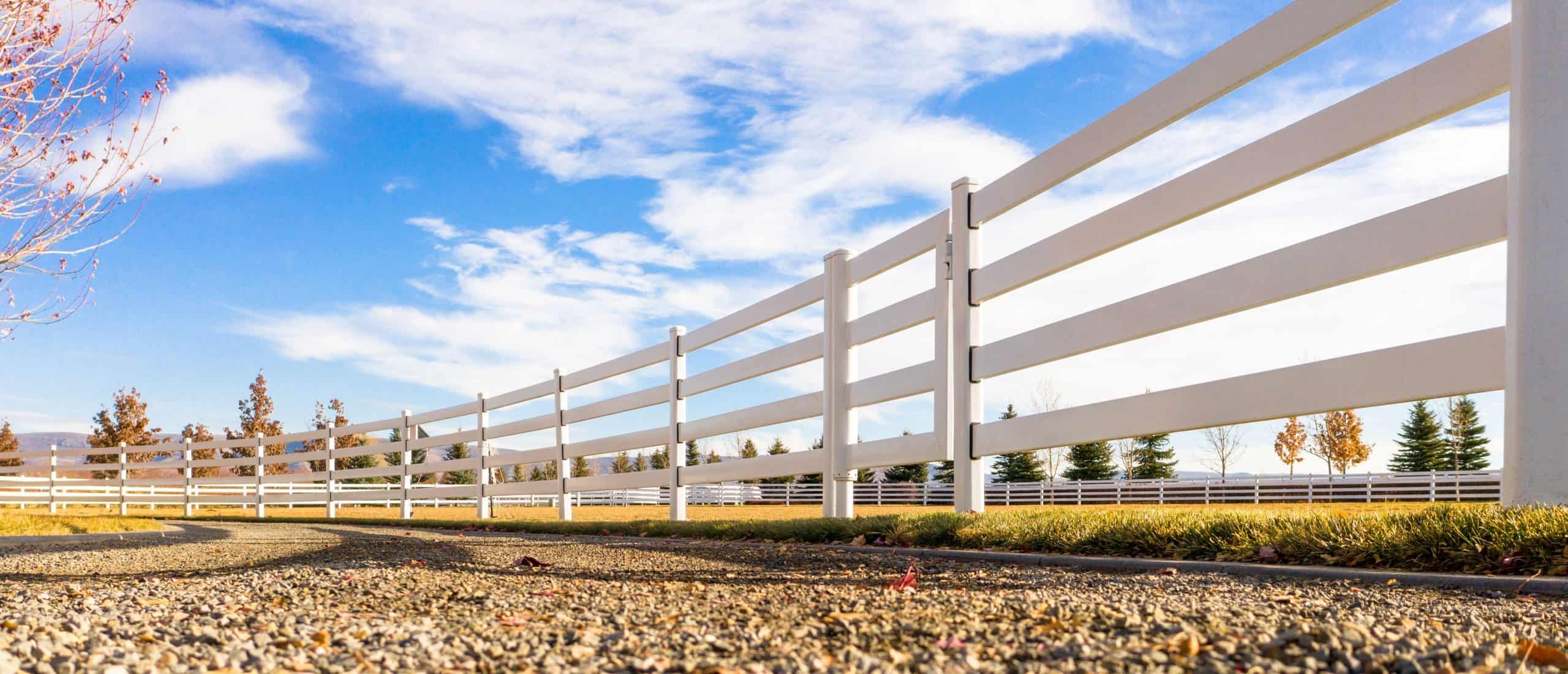Metal fencing has earned its reputation. Serious property owners understand that initial price and true value rarely share the same number. Whether you’re looking to contain livestock, protect prize horses, or simply secure your land for generations to come, the type of fence you choose today will either serve you faithfully or become a constant reminder of compromise.
We’re not here to tell you that one size fits all. It doesn’t.
Different situations call for different solutions. After decades in this business, watching trends come and go, seeing what holds up when winter bears down hard or when that stubborn gelding tests his boundaries for the hundredth time—we’ve formed some definitive opinions on what works and what doesn’t.
Below, we’ll walk you through all the types of metal fences: from steel board and pipe fencing to wire options and more exotic choices like aluminum and corrugated metal. We’ll give it to you straight—the good, the bad, and the ugly of each option.
Why Your Metal Materials Matter (a Lot)
Not all metal is created equal, and what your fence is made of determines whether you’re building something that’ll outlast you or just kicking problems down the road.
The metal in your fence isn’t just about keeping animals in or out. It’s about whether you’ll spend your Saturdays mending broken sections instead of enjoying your property. It’s about whether you’ll be replacing the whole system in seven years or passing it down to your kids decades later.
We’ve seen ranchers who thought galvanized wire was “good enough” until it started creating tetanus risks for their horses. We’ve watched folks install the wrong gauge of steel only to have it buckle under the first serious snow load. We’ve helped replace countless fences that were sold as “lifetime solutions” but couldn’t handle the basic realities of ranch life.
Temperature swings, moisture, soil chemistry, UV exposure, animal pressure…your fencing materials face a daily assault from forces that don’t care one bit about your budget constraints. The right metals stand up to these challenges; the wrong ones surrender to them, usually at the most inconvenient time possible.
When we talk steel board versus high-tensile wire versus aluminum, we’re not just comparing different looks or price points. We’re talking about fundamentally different performance capabilities. We’re talking about materials that react differently when that 1,200-pound horse leans against them or when that unexpected ice storm hits.
Quality metal fencing isn’t cheap—we won’t pretend otherwise. But replacing an inferior fence is always more expensive than doing it right the first time. The material choices you make today determine whether your fence becomes an asset that increases property value or a liability that drains your time and resources year after year.
9 Best Types of Metal Fences
We’ll walk through all the types of metal horse fences in more detail below, but let’s start with a quick-and-easy side-by-side comparison table.
| Fence Type | Safety Rating | Longevity | Maintenance Level | Initial Cost | Lifetime Value | Best Application |
| Steel Board | Excellent | 30+ years | Minimal | High | Excellent | Horse enclosures, perimeters |
| High-Tensile Wire | Poor-Fair | 15-20 years | Moderate | Low | Fair | Cattle, large property boundaries |
| Pipe Fencing | Good | 20-25 years | Moderate | High | Good | Corrals, riding arenas |
| Woven Wire | Fair | 10-15 years | High | Medium-Low | Poor | Smaller livestock, property boundaries |
| Cable Wire | Fair | 15-20 years | Moderate | Medium | Fair | Horse perimeters (with visibility strips) |
| Panel Systems | Good | 15-20 years | Low-Moderate | Medium-High | Good | Temporary enclosures, round pens |
| Chain Link | Poor | 20+ years | Low | Medium | Poor (for horses) | Dog runs, security perimeters |
| Aluminum | Good | 25+ years | Very Low | Very High | Fair | Decorative boundaries, show facilities |
| Corrugated Metal | Fair | 15-20 years | Moderate | Medium | Poor | Wind breaks, privacy screens |
1. Steel Board Fence
Steel board fences stand at the top of the heap for serious horse owners who refuse to compromise on safety or longevity. These systems feature horizontal steel boards that combine the classic aesthetics of wood with the unmatched durability of premium metals.
Quality steel board fencing eliminates the primary risks to horses: no sharp edges, no chance of legs getting caught, and exceptional visibility that prevents accidents before they happen. The smooth, continuous surface gives nothing for curious horses to catch or chew.
While the upfront investment is higher, the math becomes clear over time: minimal maintenance requirements, no painting headaches, and a lifespan measured in generations rather than years. For properties where horses are the priority, nothing else delivers the same peace of mind or long-term value.
2. High-Tensile Wire
High-tensile wire fencing offers an economical solution for containing livestock across large acreages, but comes with significant trade-offs. The system uses tightly stretched steel wires that can withstand substantial pressure without breaking.
The appeal is obvious. Low material costs and relatively quick installation make it attractive for covering extensive boundaries. For cattle operations on tight budgets, it checks the basic containment box.
However, for horses, the risks can’t be overstated. Poor visibility leads to collisions, and wire can cause severe lacerations if a horse runs into or gets caught in it. Maintenance becomes a constant battle against tension issues and sagging. While it’s a functional option for certain applications, high-tensile wire is a compromise that many come to regret when animal safety is at stake.
3. Pipe Fencing
Pipe fencing has earned its place on working ranches for its durability and reasonable safety profile. Constructed from galvanized or powder-coated steel pipes in horizontal rows, it offers substantial strength against both animal and weather pressure.
The rounded surfaces reduce injury risks compared to wire options, and its visibility helps prevent collisions. For corrals, round pens, and high-traffic areas, pipe fencing stands up to the daily abuse that would destroy lesser materials.
The downsides emerge over time, though. Paint chips and scratches eventually lead to rust issues, welded joints can fail, and the overall aesthetic dulls with age. While pipe fencing is a solid middle-ground option that many ranchers find acceptable, it still falls short of steel board in both safety features and long-term value proposition.
4. Woven Wire
Woven wire fencing (sometimes called field fencing) combines vertical and horizontal wires in a mesh pattern that creates smaller openings than high-tensile systems. This design improves containment for smaller animals while maintaining relatively low costs.
The woven structure distributes impact forces better than single-strand options, reducing the chances of complete failure when tested. For properties with multiple species of varying sizes, it provides versatile containment.
However, horses are still vulnerable to catching hooves in the openings or sustaining cuts from the wire. Visibility is marginal at best, and the lighter gauge metals commonly used tend to sag and deform within just a few seasons. Sure, it’s functional for certain mixed-use applications, but woven wire requires compromise on both safety and longevity that premium horse operations typically avoid.
5. Cable Wire
Cable wire fencing takes a middle ground between high-tensile wire and more premium options. It uses thicker, coated steel cables with better visibility than standard wire. This system attempts to address some of the safety concerns while maintaining cost advantages.
The flexibility of the cables reduces injury severity during impacts, and when properly installed with adequate tension, it creates clean boundary lines that complement various property styles. Some versions include visibility strips that further reduce collision risks.
However, cable systems still present legitimate safety concerns for horses. Maintenance becomes an ongoing chore as tension adjustments and occasional replacements are inevitable. While cable fencing is an upgrade from basic wire options, it still falls short of the safety profile and longevity that dedicated horse owners typically demand for their primary enclosures.
6. Panel Systems
These pre-fabricated metal sections connect to create instant enclosures without the complexity of traditional fence building.
They solve problems that permanent fencing struggles to address for temporary containment, round pens, and facilities that require periodic reconfiguration. The sturdy construction typically provides adequate safety for controlled environments, and installation requires minimal expertise.
Unfortunately, the connecting points create weak spots, standardized sizes limit customization, and the overall system lacks the refined appearance of premium permanent options. It’s excellent for specific applications, but panel systems work best as a complement to (rather than replacement for) quality permanent fencing for primary horse enclosures.
7. Chain Link Fence
Chain link fencing is still around primarily due to its affordability and security focus rather than its suitability for livestock. The woven metal design creates a visible barrier that effectively contains smaller animals and deters human trespassers.
For dog runs, security perimeters, and general property division, chain link provides acceptable functionality at moderate cost. Its widespread availability and standardized installation make it a convenient option for non-critical applications.
However, for horses, chain links just don’t work: from caught hooves to potential entanglement during panic situations. The thin metal is easily deformed by larger animals, and sharp edges can develop at damaged sections. It’s durable against the elements, but chain link simply wasn’t designed with equine safety in mind.
8. Aluminum Fencing
Aluminum fencing brings elegance and virtually maintenance-free performance to the table. The inherent corrosion resistance eliminates rust concerns, while the lighter weight simplifies installation.
What sets quality aluminum systems apart is their durability without the maintenance headaches: no painting, no rust repair, and minimal cleaning requirements. For properties where aesthetics matter as much as function, Aluminum provides a refined appearance that improves overall value.
The biggest drawback is cost. Premium aluminum fencing is one of the highest initial investments among metal options. It’s safe for horses when properly designed, but it lacks the sheer strength of steel and can be damaged by determined large animals. For showcase properties and non-agricultural applications, aluminum can be advantageous, but most working ranches find better value elsewhere.
9. Corrugated Metal
Corrugated metal fencing serves functional purposes rather than acting as a primary containment system. The ribbed metal sheets create solid barriers that block wind, provide privacy, and define clear boundaries with minimal materials.
In practical applications, corrugated metal creates windbreaks for livestock, privacy screens around work areas, and durable barriers in high-erosion zones. The relatively low cost and simple installation make it accessible for utilitarian needs around a working property.
However, the sharp edges and potential for rust make corrugated metal a poor choice for direct animal contact. Safety concerns eliminate it from consideration for primary horse enclosures, and its industrial appearance limits its use in visible areas of premium properties.
Pick Steel Board for Your Horses…Every Time
When the dust settles and all factors are weighed, steel board fencing stands as the best option that refuses to compromise on what matters most. We’ve seen it outlast everything else on the market while keeping horses safer than any alternative.
The math is simple: pay once for peace of mind that lasts decades, or pay repeatedly for systems that keep you up at night worrying about your animals. Your horses deserve better than “good enough,” and your property deserves an investment that appreciates rather than deteriorates.
Quality steel board fencing isn’t just a purchase—it’s a statement about your standards and priorities. Some decisions on a ranch are complicated…this one isn’t. Give us a call, and let’s talk about your fencing needs.



